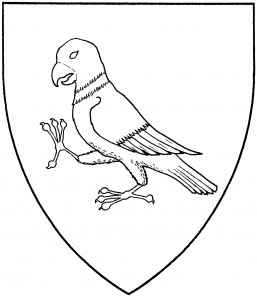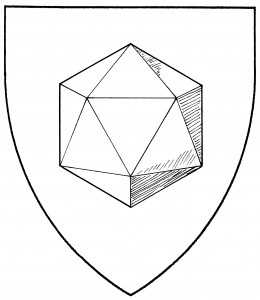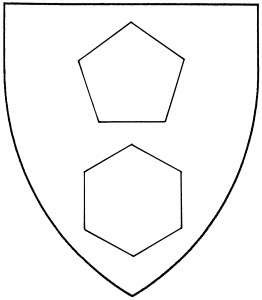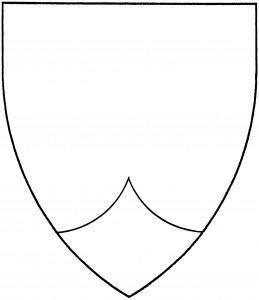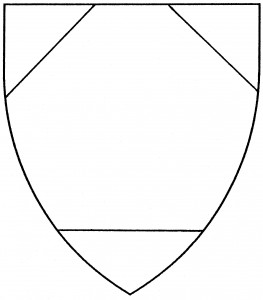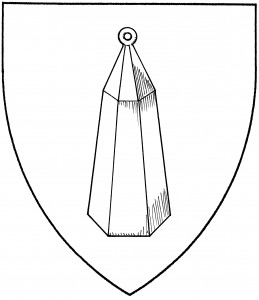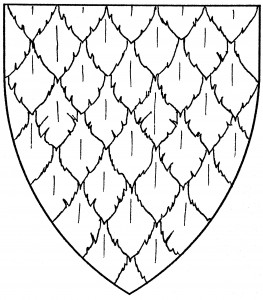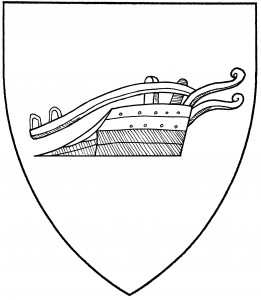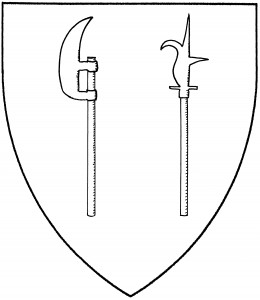
Berdiche (Period); billhook (Period)
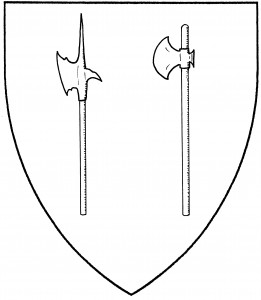
Halberd (Period); pole-axe (Period)
This class of weapon is characterized by the long shaft by which damage may be inflicted at a safer distance. Usually a sharp implement is attached to the pole’s end, and it is by this head (to chief by default) that most pole-weapons are identified.
Examples of pole-arms found in period armory include the “berdiche”, whose backswept blade is fastened to the haft at its center and bottom points, found in the arms of Kürnburg, 1548 (Vigil Raber’s Armorial of the Arlberg Brotherhood of St. Christopher, fo.48); the “billhook”, a spear with a hooked blade, found in the canting arms (Italian roncola) of Roncha or Runche, c.1555 [BSB Cod.Icon 275:119 and 276:205]; the “halberd”, with an upswept blade, and a spike on the end of the haft, as in the arms of von Griffenstein, c.1515 [BSB Cod.Icon 308:391; also von Schella, 1605, Siebmacher 43]; and the “pole-axe”, with a standard battle-axe head and a long haft, as in the canting arms of Mordaxt, 1548 (Vigil Raber’s Armorial of the Arlberg Brotherhood of St. Christopher, fo.133). Strictly speaking, any axe on a long pole is a “pole-axe”: the pole-axes in the arms of the Worshipful Company of Butchers, granted 1540, have been depicted both as battle-axes and as nondescript “chopping” axes [Bromley & Child 34].
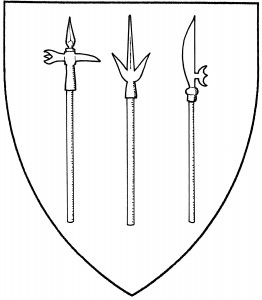
Bec de corbin (Accepted); corsica (Accepted); fauchard (Accepted)
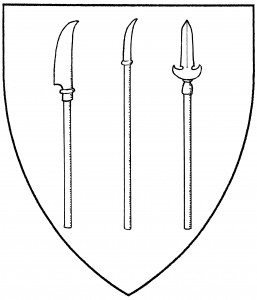
Glaive (Accepted); naginata (probable SFPP); partisan (Accepted)
Other pole-arms, used as weapons and accepted for Society armory, include the “bec de corbin”, a long-handled war-hammer c.1400, with a curved point like a raven’s beak, from which it takes its name [Stone 109]; the “corsica” or “corsèque”, 15th and 16th C., with broad, branched blades joined to the main blade [Stone 374, s.v. korseke]; the “fauchard”, 16th C., with a falchion-shaped blade [Stone 226]; the “glaive”, 12th and 13th C., whose single-edged blade has a backwards-curving tip [Stone 248]; the “naginata”, a Japanese spear with a back-curving blade [Stone 463]; the “partizan” or “partisan”, 16th C., a double-edged spear with short, hooked blades at the base of the head, very like a corsica [Stone 484]; the “war-scythe”, 16th C., essentially a scythe blade mounted on a long, straight shaft [Stone 545]; and the “Swiss voulge” or “vouge”, 14th C., favored by the infantry of that tiny nation [Stone 654].
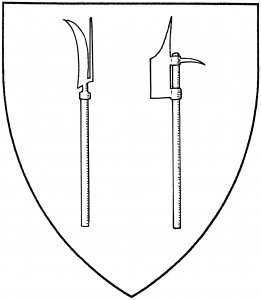
War-scythe (Accepted); Swiss voulge (Accepted)
For related charges, see hammer, mancatcher, spear, trident.
The Baron of Bjornsborg bears: Azure, two bears rampant addorsed regardant argent, each sustaining a berdiche proper, in base a laurel wreath Or.
Andrew Mariner bears: Argent, two billhooks addorsed in saltire sable, a chief doubly enarched vert.
Shandon Yar Mohamed Gehazi Memo Hazara Khan-ad-Din bears: Per bend sinister raguly sable and Or, a sun of six greater and six lesser points and a naginata bendwise sinster counterchanged.
Christopher of Eoforwic bears: Per pale Or and sable, three glaives fesswise in pale, blades to chief, the first and third reversed, between two goblets in bend counterchanged.
Lucas Otto Gustav Oswald Stefan bears: Checky vert and argent, a partisan bendwise surmounted by a snail shell reversed Or.
Aldwin Yale of York bears as a badge: Per bend sinister sable and Or, a compass star and a corsica bendwise sinister counterchanged, within a bordure embattled gules.
Charles Greenlimb bears: Per bend embattled gules and azure, two war-scythe heads bendwise, issuant from chief the point to sinister and issuant from dexter the point in base, argent.
Johannes Kaspar Zurfluh bears: Per fess embattled argent and gules, an eagle displayed and a Swiss voulge bendwise sinister reversed counterchanged.
Alexia of Thessalonica bears: Per bend Or and purpure, a bec de corbin bendwise vert and a whelk bendwise Or.
